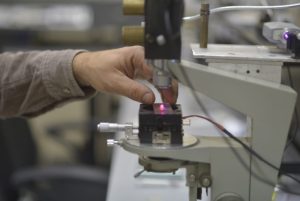The Quantum Materials Unit focuses on the experimental and theoretical investigation of quantum materials, including strongly correlated electron systems, unconventional superconductors and low-dimensional magnets. The unit explores how interactions between charge, spin, orbital, and lattice degrees of freedom give rise to complex emergent phenomena.

A core aspect of the research involves Raman and infrared spectroscopy conducted under variable temperature and strain conditions. Experimental data are complemented by theoretical modeling to reveal the microscopic mechanisms governing phase transitions, electronic order, and quasiparticle behavior in these materials.
This will close in 0 seconds
This unit investigates a broad spectrum of nanostructured materials—including metal oxides, multiferroic composites, orthoferrites, and rare-earth garnets—focusing on their structural, optical, magnetic, and vibrational properties.

Applications span water purification, photovoltaics, and electromagnetic shielding. The research also explores how nanoscale architecture influences spin and charge dynamics, with particular emphasis on quantum coherence and spin-based information processing. A subgroup of the unit employs Raman and SERS techniques to study biological systems, using custom statistical tools to interpret complex cellular and molecular data.
This will close in 0 seconds
The 2D Materials Unit focuses on the study of two-dimensional materials, their heterostructures, and ordered nanostructures in photonics, investigating their optical, electrical, thermal, and mechanical properties. Research ranges from the design and engineering of structures with tailored functionalities to their fabrication, characterization, and theoretical modeling.

The unit aims to bridge fundamental understanding with practical applications, particularly in plasmonics, flexible electronics, and photovoltaics.
This will close in 0 seconds
This unit specializes in the characterization of a broad range of electronic materials using techniques such as vibrational spectroscopy, AFM and SEM microscopy, photoluminescence spectroscopy, and magneto-optical measurements. Research targets include A4B6 and A2B6 semiconductors doped with magnetic impurities (bulk materials, thin films, and nanomaterials), white phosphors, multiferroics, and magneto-optical crystals. A dominant research focus is on the mechanisms of nanostructure formation in different systems and on plasmon–phonon interaction.

This will close in 0 seconds
The Structural Characterization Unit explores the delicate hierarchical atomic architecture and nanoscale fluctuations that underlie precursor, emergent, and hidden states in advanced materials. With a strong focus on the interplay between local atomic structure and physical properties, the lab investigates complex quantum and functional materials—spanning charge, orbital, and spin interactions.

Specializing in identifying electronically driven nanoscale heterogeneities, the lab tackles cutting-edge systems such as strongly correlated oxides, charge density wave materials, topological phases, high-performance thermoelectrics, and structurally disordered compounds.
This will close in 0 seconds